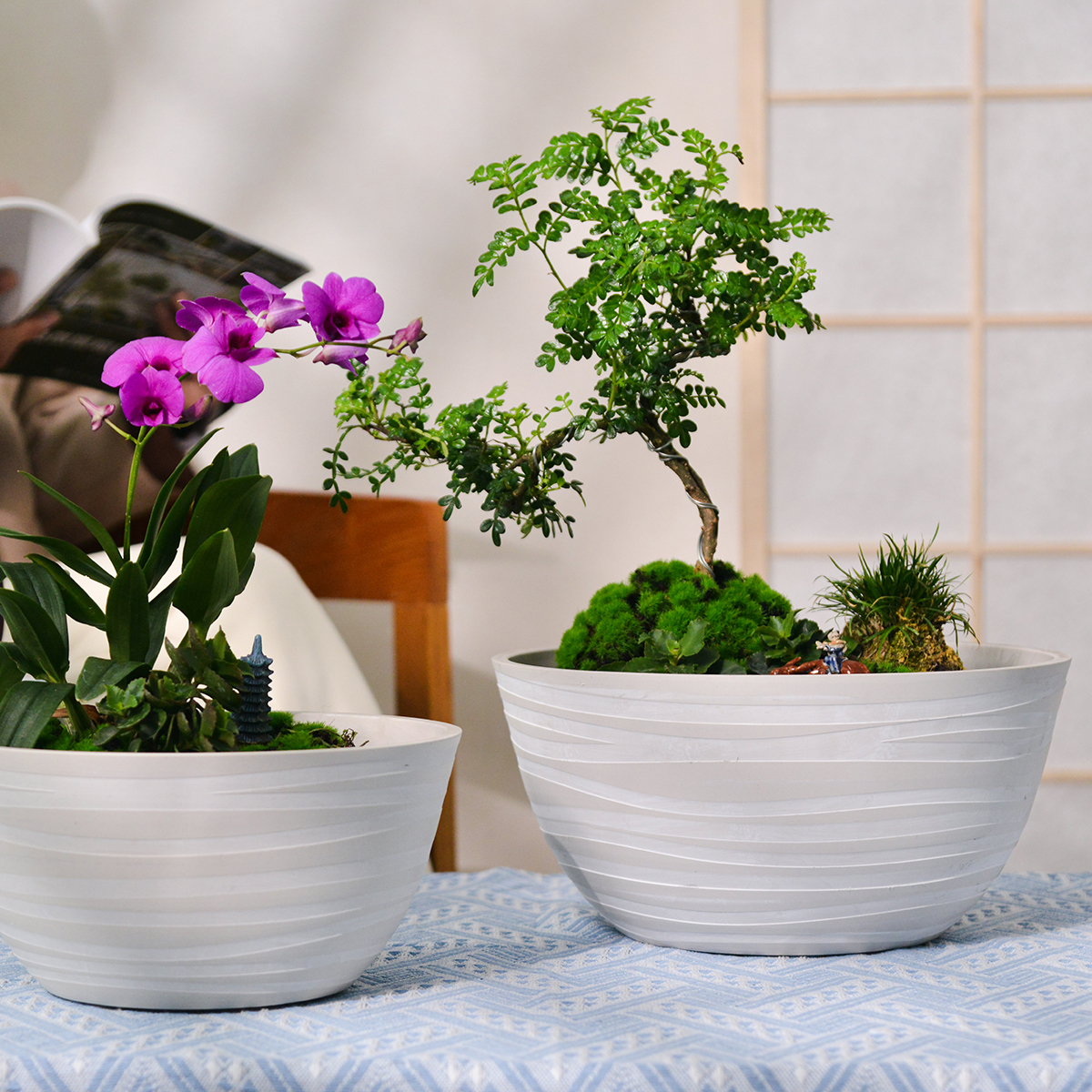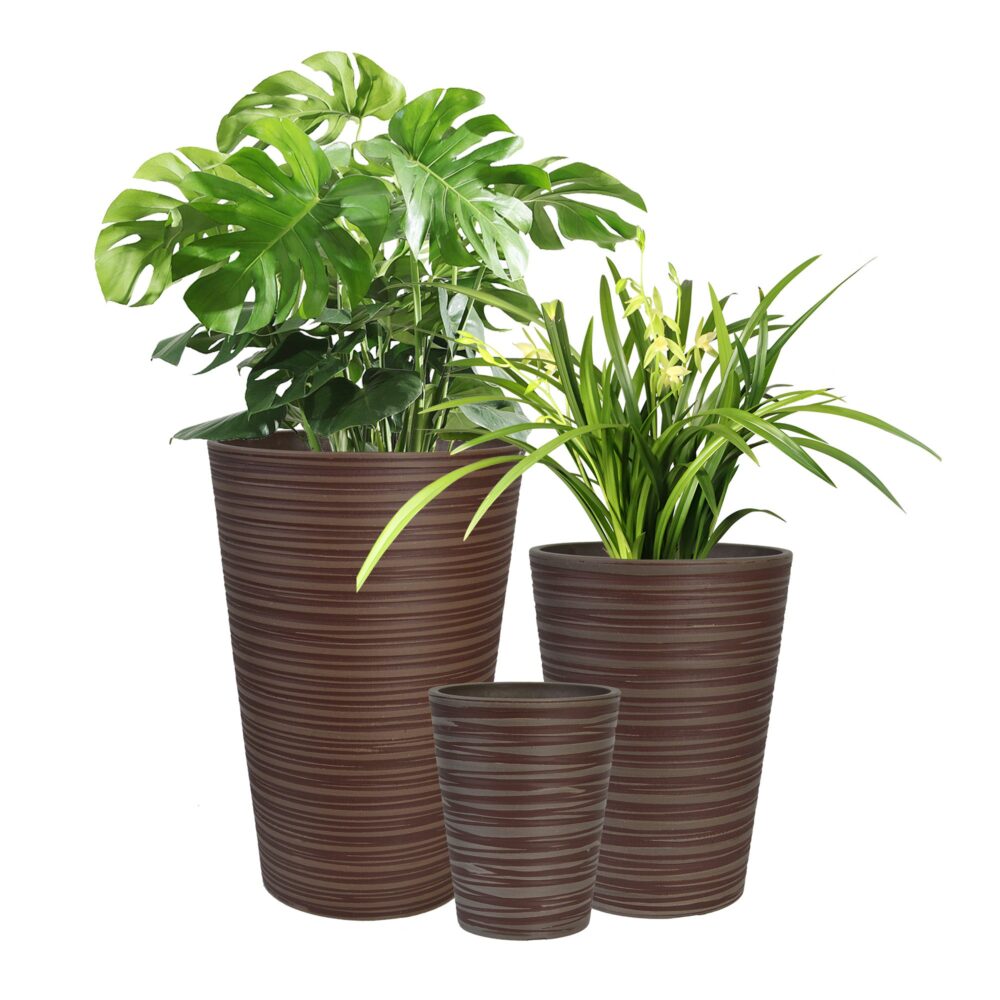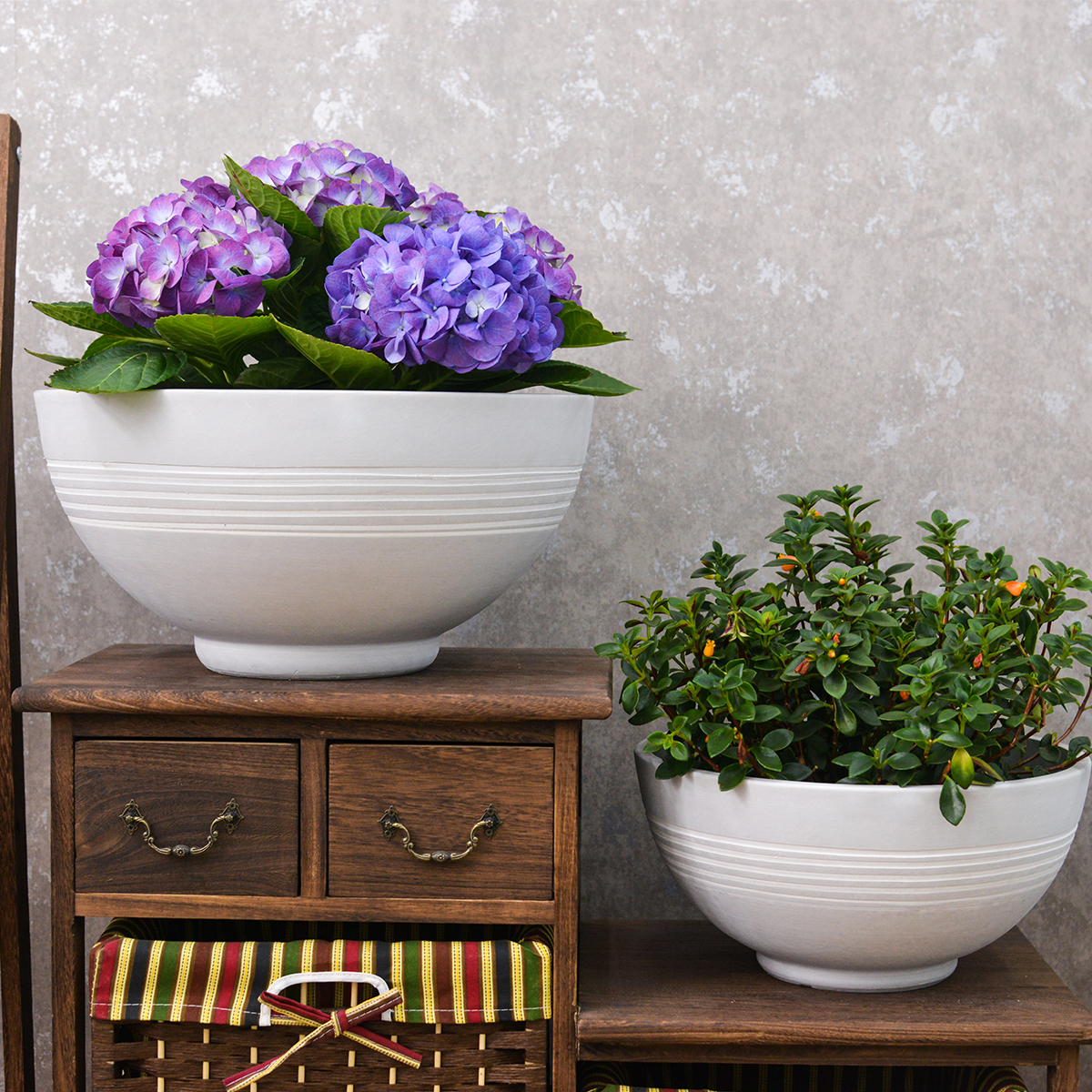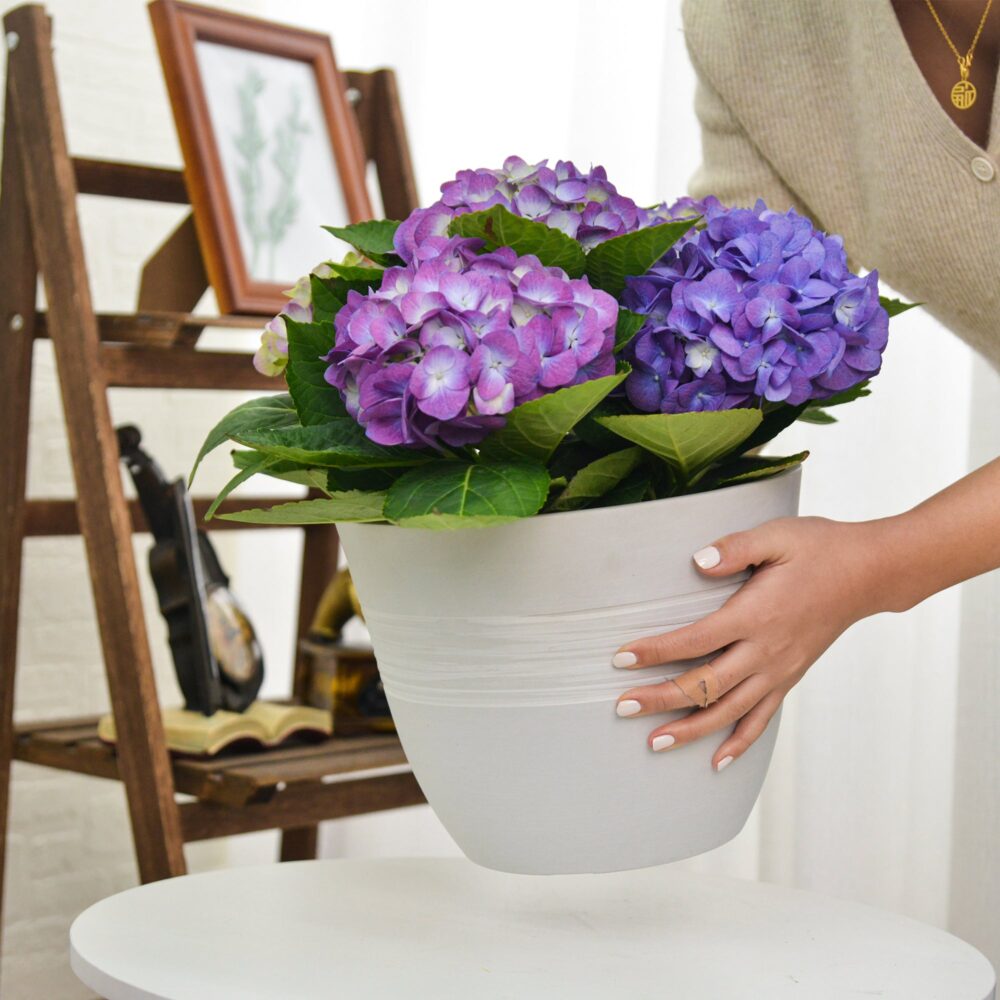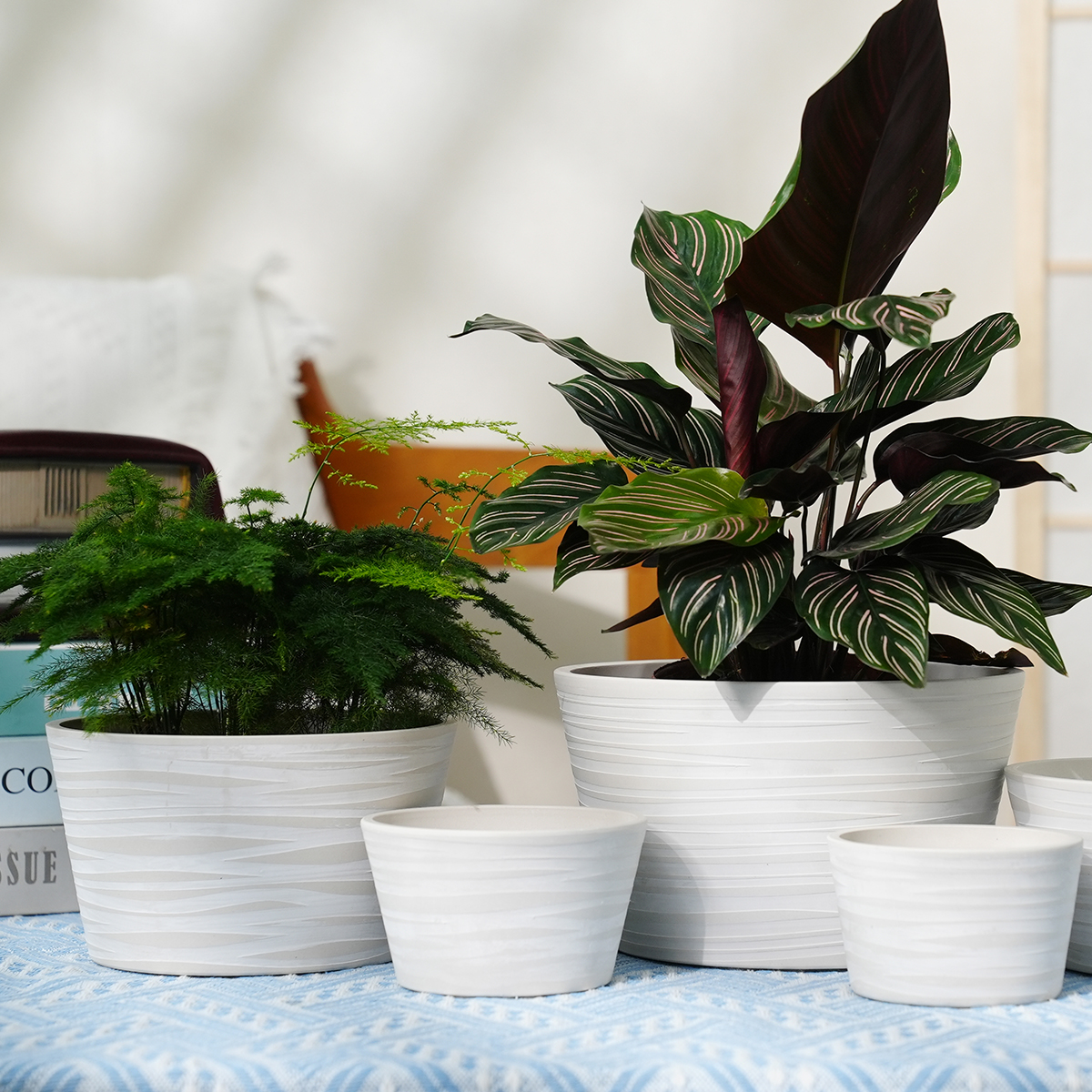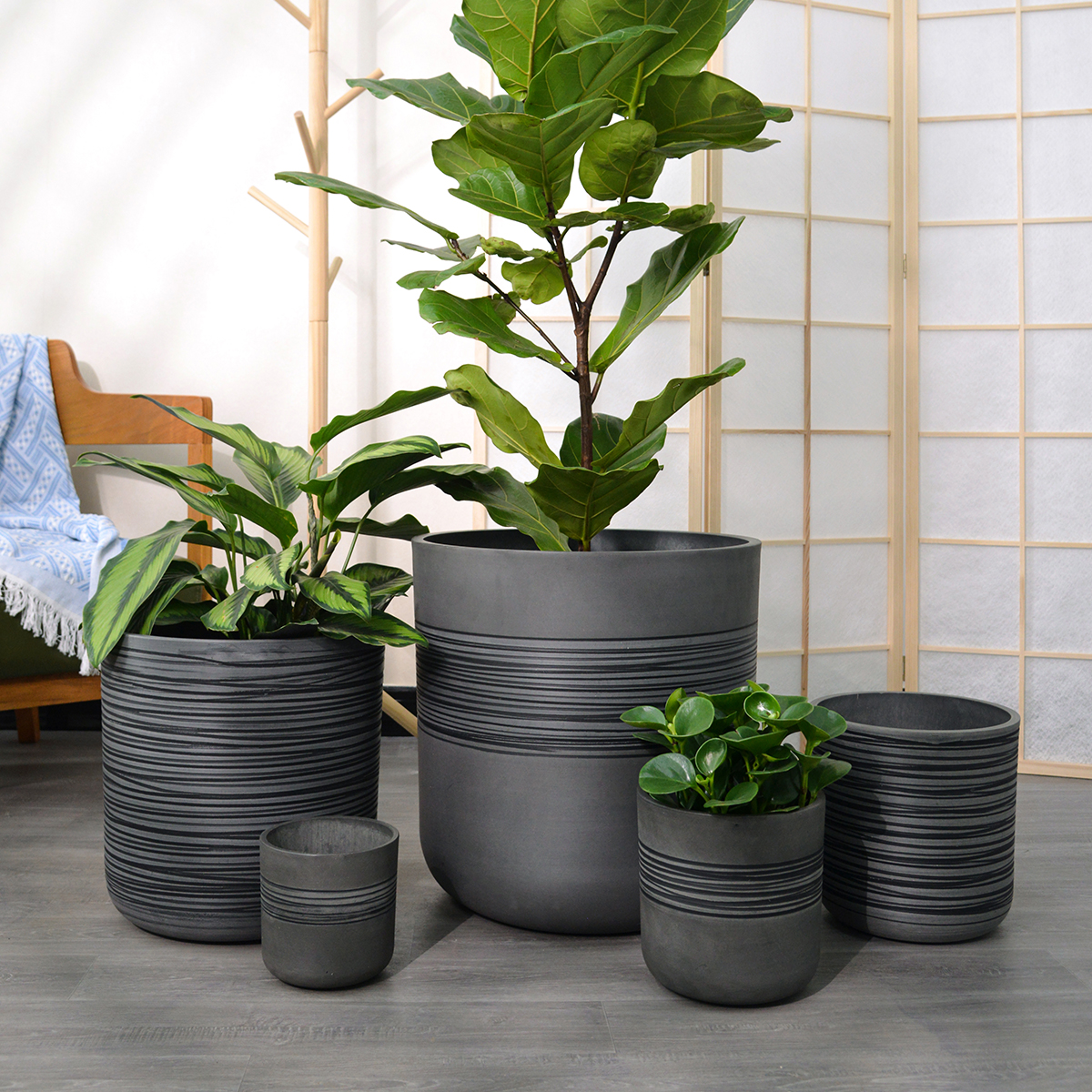Salvia in Pots: The Ultimate Guide to Growing Vibrant Sages Outdoors in Containers
Want to bring a touch of vibrant color, aromatic foliage, and pollinator-attracting beauty to your patio, balcony, or garden? Salvia, commonly known as Sage, is an exceptional and rewarding choice for outdoor container gardening. Celebrated for their long blooming season, diverse flower colors and forms, and often fragrant foliage, Salvias are perfect for adding low-maintenance beauty and attracting hummingbirds, butterflies, and bees to sunny outdoor spaces. This comprehensive guide will provide you with everything you need to know to grow Salvia successfully in outdoor pots, from selecting the best varieties and containers to mastering essential care techniques for a season filled with Salvia splendor.
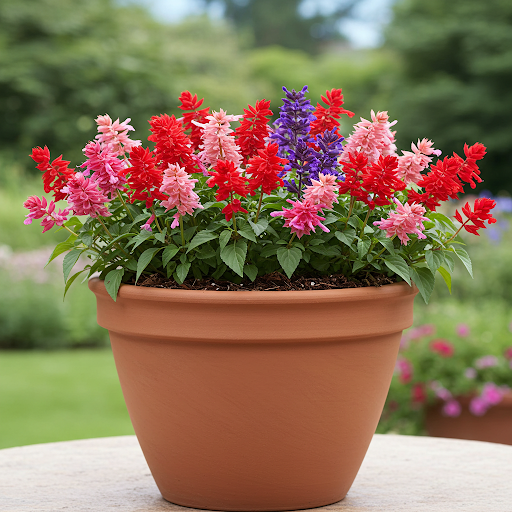
Salvia
What are Salvia (Sage)?
Salvia, commonly known as Sage, is the largest genus in the mint family, Lamiaceae, encompassing a vast array of species, cultivars, and hybrids of flowering plants. Native to regions around the world, Salvias are popular annuals, biennials, or perennials grown for their showy flower spikes, often aromatic foliage, and long blooming season. Salvia flowers come in a breathtaking array of colors, including red, purple, blue, pink, orange, yellow, white, and bi-colors, and in various shapes and sizes, from small and delicate to large and dramatic. Salvia plants exhibit diverse growth habits, from compact and bushy to upright and spreading, ranging in height from under a foot to several feet tall, depending on the species and variety. They are known for their heat and drought tolerance, long blooming season (spring to fall, and even year-round in mild climates), vibrant colors, aromatic foliage (in many varieties), and exceptional attractiveness to pollinators, making them an invaluable addition to gardens and containers, especially for attracting wildlife and adding low-maintenance, long-lasting color.
Are Salvia (Sage) Good for Outdoor Pots?
Yes, Salvia (Sage) are exceptionally well-suited for outdoor pots and container gardening. Their adaptable growth habits, long blooming season, drought tolerance, and attractiveness to pollinators make them ideal for filling pots, window boxes, mixed containers, and even vertical gardens with vibrant color and texture. Salvias thrive in sunny locations and bloom profusely throughout the warm season, providing a long-lasting and delightful floral display in containers. Their relatively low-maintenance nature and striking beauty make them a fantastic and rewarding choice for container gardens of all styles, especially for adding a touch of Mediterranean, cottage, or contemporary flair to patios, balconies, and decks.
Ideal Growing Conditions for Salvia in Pots:
Types of Salvia for Pots: With hundreds of Salvia species and cultivars, there’s a Salvia for almost every pot size and style. Consider these popular types for containers:
- Annual Salvias: (e.g., Salvia splendens (Scarlet Sage), Salvia farinacea (Mealycup Sage), Salvia coccinea(Blood Sage)) – Fast-growing and bloom profusely in their first year, typically grown as annuals in most climates. Excellent for pots, window boxes, and mixed containers, providing instant color and often vibrant hues of red, blue, and purple. Choose compact varieties for pots.
- Perennial Salvias: (e.g., Salvia nemorosa (Woodland Sage), Salvia greggii (Autumn Sage), Salvia microphylla(Baby Sage), Salvia x sylvestris (Meadow Sage)) – Return year after year in suitable climates (hardy to various USDA zones, check variety hardiness). Excellent for larger pots and long-term container displays, offering a wider range of flower colors, foliage textures, and often greater drought tolerance. Choose compact or medium-sized perennial Salvia varieties for pots.
- Culinary Sage: (Salvia officinalis) – While primarily grown for culinary use, common sage and its cultivars (e.g., ‘Berggarten’, ‘Purpurascens’) can also be attractive in pots, offering grey-green foliage, and sometimes flowers, along with their culinary and medicinal properties. Good for herb gardens in pots or mixed containers with other herbs and flowers.
- Hummingbird Salvias: (e.g., Salvia guaranitica (Anise Sage), Salvia elegans (Pineapple Sage), Salvia ‘Black and Blue’) – Known for their tubular flowers in vibrant colors (often red, blue, or purple) that are particularly attractive to hummingbirds. Excellent for larger pots to attract pollinators and create a wildlife-friendly container garden. Pineapple Sage also offers fragrant foliage.
Light: Salvias thrive in full sun. They need at least 6-8 hours of direct sunlight per day to bloom profusely and maintain vibrant colors and healthy growth. Choose a sunny location for your Salvia containers, such as a south-facing patio, balcony, or garden bed. In shady locations, Salvias will produce fewer blooms, become leggy, and may be more susceptible to diseases. Full sun is essential for optimal flowering, compact growth, and best foliage color and fragrance (in fragrant varieties).
Soil: Salvias need well-draining soil that is moderately fertile. Use a high-quality potting mix specifically formulated for containers or flowers. Amend potting mix with perlite or vermiculite to improve drainage and aeration, especially for varieties that prefer drier conditions (like many perennial Salvias). Avoid heavy, compacted soil or garden soil in pots, as they can become waterlogged. A slightly acidic to neutral pH (around 6.0-7.0) is ideal for most Salvias. Excellent drainage is crucial to prevent root rot, especially in pots.
Watering: Salvias are relatively drought-tolerant once established, especially perennial varieties, but perform best with regular watering, especially when young, blooming, and in hot weather. Water thoroughly when the top inch of soil feels dry. Water deeply until water drains out of the drainage holes. Allow the soil surface to dry slightly between waterings. Avoid overwatering and soggy soil, which can lead to root rot. Many Salvias prefer slightly drier conditions and are more tolerant of underwatering than overwatering. Watering frequency will depend on weather conditions, light levels, pot size, and plant size. During hot, sunny, or windy weather, you may need to water more frequently. Check soil moisture regularly and adjust watering accordingly. Water at the base of the plant to keep foliage and flowers dry and help prevent fungal diseases.
Temperature: Salvias are generally warm-weather plants that thrive in warm to hot temperatures. They perform best in temperatures between 60°F to 90°F (15°C to 32°C). Hardiness varies greatly depending on the Salvia species and variety. Annual Salvias are sensitive to frost and freezing temperatures and are typically grown for one season. Perennial Salvias have varying degrees of cold hardiness, ranging from USDA zone 3 to zone 10, depending on the species and cultivar. Choose Salvia varieties that are hardy in your USDA hardiness zone if you intend to overwinter them outdoors in pots. In colder zones, perennial Salvias in pots may need winter protection (see “Winter Protection” below). Salvias bloom most profusely in warm weather and may slow down or stop blooming in very hot, prolonged heat stress conditions. Providing some afternoon shade in extremely hot summer climates can be beneficial for some varieties.
Fertilizer: Salvias are light to moderate feeders and generally do not require heavy fertilization. Over-fertilizing can lead to leggy growth and fewer flowers. Fertilize sparingly, once or twice during the growing season, if needed, especially for annual Salvias in pots. Use a balanced liquid fertilizer (e.g., 10-10-10 or 20-20-20) diluted to half strength, or a fertilizer specifically formulated for flowering plants. Alternatively, you can amend the potting mix with slow-release fertilizer granules at planting time. Avoid over-fertilizing, especially with high-nitrogen fertilizers, which can promote leafy growth at the expense of blooms and fragrance. Perennial Salvias often require even less fertilization than annual types.
Choosing the Right Pots for Salvia:
Suitable Pot Types: Salvias are adaptable to various pot types, including terracotta, ceramic, plastic, resin, metal, and raised beds. Consider these factors when selecting pot types for Salvias:
- Terracotta Pots: Porous, allow excellent aeration and drainage, and aesthetically classic. Terracotta is a particularly good choice for Salvias, especially perennial types that prefer drier conditions, as it helps prevent overwatering. However, terracotta pots also dry out more quickly, so monitor soil moisture, especially in hot weather.
- Ceramic Pots: Available in many decorative styles, can add a decorative element to your container garden, and retain moisture reasonably well. Ensure good drainage. Glazed ceramic pots retain moisture better than unglazed terracotta. Choose based on your desired aesthetic and moisture retention needs.
- Plastic Pots: Lightweight, inexpensive, retain moisture well, and are available in various colors and styles. Excellent choice for Salvias, especially for moisture retention in sunny, hot locations, and for larger pots that need to be moved. Choose good quality plastic pots with drainage holes. Lighter colored plastic pots may heat up less in direct sun.
- Resin Pots: Lightweight, durable, available in various styles mimicking terracotta or ceramic, and offer a balance of drainage and moisture retention. A good alternative to heavy ceramic pots, and often more durable than terracotta or plastic.
- Metal Pots & Containers: Can add a modern or rustic touch. Ensure metal pots have drainage holes and are lined if necessary to prevent rust and protect roots from excessive heat in sunny locations.
- Raised Beds or Large Troughs: For larger Salvia displays or mixed plantings, raised beds or long troughs can be excellent choices, providing ample space for root growth and creating a more garden-like feel on patios or balconies.
Drainage: Excellent drainage is essential for Salvias to prevent root rot. Ensure your chosen pot has drainage holes at the bottom. Avoid pots without drainage holes. Adding a layer of gravel or pot shards at the base of the pot is generally not necessary if using a well-draining potting mix, but can be done for extra precaution, especially in heavier pots. Elevating pots slightly on pot feet or bricks can further improve drainage and air circulation around the base.
Pot Size: Choose pot sizes appropriate for the type and mature size of the Salvia you are planting, and the desired display.
- Annual Salvias: For compact annual Salvias, pots that are 8-10 inches in diameter are suitable for individual plants. For fuller displays or mixed plantings, use pots that are 10-14 inches or larger, or window boxes.
- Perennial Salvias: For perennial Salvias, especially medium to larger varieties, use pots that are 12-18 inches in diameter or larger for individual plants, or larger troughs or raised beds for multiple plants. Choose wider and deeper pots to accommodate their often more extensive root systems and longer lifespan.
- Depth: Ensure pots are at least 8-10 inches deep for annual Salvias, and 10-14 inches deep or more for perennial Salvias to provide adequate root space. Deeper pots are generally better for all types, especially in warmer climates, to provide more consistent soil moisture and insulation for roots.
Color and Style: Choose pot colors and styles that complement your Salvia blooms and your outdoor décor. Terracotta pots enhance the natural, Mediterranean, or cottage garden look of many Salvias. Brightly colored pots can create a more vibrant and contemporary display, especially for annual Salvias with bold flower colors. Neutral pots in white, gray, black, or natural stone tones can provide a clean and elegant backdrop and allow the Salvia flowers and foliage to be the main focus. Consider the overall style of your patio or garden and choose pots that harmonize with the surroundings.
Essential Care Tips for Thriving Salvia in Outdoor Pots:
- Watering: “Water When Top Inch of Soil is Dry, Avoid Overwatering”. Water thoroughly when the top inch of soil feels slightly dry. Water deeply until water drains from drainage holes. Allow soil surface to dry slightly between waterings. Avoid overwatering and soggy soil. Water more frequently during hot, sunny, or windy weather.
- Sunlight: Provide Full Sun (6-8+ Hours Daily). Place Salvia pots in a location that receives full sun for best blooming, vibrant colors, and healthy growth.
- Fertilizing: Fertilize Sparingly, Once or Twice During Growing Season (If Needed). Fertilize sparingly, once or twice during the growing season, if needed, with a balanced liquid fertilizer or flowering plant fertilizer. Avoid over-fertilizing.
- Deadheading (Encourage More Blooms & Tidiness): Deadhead spent or faded flower spikes regularly to encourage more blooms and keep plants looking tidy. Snip off faded flower spikes at the base of the spike or just below the spent flowers. Regular deadheading is very beneficial for most Salvias and promotes continuous flowering throughout the season.
- Pruning (For Bushier Growth & Reblooming): Pinch back stem tips of young Salvias to encourage branching and bushier growth. For perennial Salvias, prune back plants in early spring to remove dead growth and encourage fresh new growth. Many perennial Salvias can also benefit from a light shearing back after their first major bloom flush to encourage reblooming later in the season.
- Winter Protection (For Perennial Salvias in Cold Climates): In colder USDA zones where perennial Salvias may not be fully hardy in pots, provide some winter protection:
- Move pots to a sheltered location: Move pots to an unheated garage, shed, or basement to protect roots from freezing.
- Insulate pots: Wrap pots with burlap, bubble wrap, or blankets to insulate the root ball.
- Mulch: Apply a thick layer of mulch around the base of the plants in the pots to insulate the soil.
- Water sparingly in winter: Water only occasionally in winter to prevent the soil from completely drying out, but avoid overwatering dormant plants.
- Pest and Disease Control: Salvias are generally relatively pest and disease-resistant, but monitor for common pests like aphids, spider mites, whiteflies, and slugs/snails. Fungal diseases like powdery mildew and root rot can occur, especially in overly humid or wet conditions, or with poor air circulation. Ensure good air circulation by spacing plants adequately, avoid overcrowding, water at the base of the plant, and provide good drainage. Treat any pest or disease issues promptly with insecticidal soap, horticultural oil, neem oil, or appropriate fungicides if necessary.
Popular Salvia Cultivars for Pots (by Type/Color/Use):
- Annual Salvias (Red): Salvia splendens ‘ রেড হট স্যালি’, ‘Bonfire’, ‘Scarlet King’
- Annual Salvias (Blue/Purple): Salvia farinacea ‘Victoria Blue’, ‘Henry Duelberg’, Salvia viridis ‘Blue Monday’
- Perennial Salvias (Blue/Purple): Salvia nemorosa ‘May Night’, ‘Caradonna’, Salvia x sylvestris ‘Blue Hill’, ‘Marcus’
- Perennial Salvias (Red/Pink): Salvia greggii ‘Hot Lips’, ‘Lipstick’, ‘Wild Thing’, Salvia microphylla ‘Hot Ember’
- Hummingbird Salvias: Salvia guaranitica ‘Black and Blue’, ‘Amistad’, Salvia elegans (Pineapple Sage), Salvia coccinea ‘Summer Jewel Red’
- Culinary Sage: Salvia officinalis (Common Sage), ‘Berggarten’, ‘Purpurascens’, ‘Tricolor’
- Compact Salvias for Pots: ‘Sunsatia Cranberry’, ‘Mystic Spires Blue’, ‘Lyrical Blues’, ‘Big Blue’
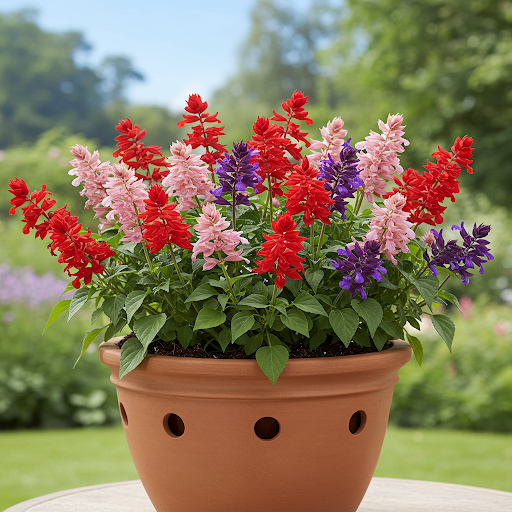
Salvia
In Summary:
Growing Salvia (Sage) in outdoor pots is a wonderfully rewarding way to add vibrant color, aromatic foliage, and pollinator-attracting beauty to your patios, balconies, and gardens. Their long blooming season, diverse colors and forms, and relatively low-maintenance nature make them a perfect choice for container gardeners seeking long-lasting beauty and wildlife-friendly plants. By providing full sun, well-draining potting mix in pots with drainage, watering appropriately and allowing soil to dry slightly between waterings, fertilizing sparingly if needed, and deadheading spent flowers, you can easily cultivate thriving Salvia plants in pots and enjoy their cheerful Sage charm all season long.
For more detailed botanical information and to explore the vast world of Salvia species and cultivars, you can visit the Wikipedia page on Salvia.
Important Note: Salvia (Sage) plants are generally considered non-toxic to humans and pets, although some species may cause mild skin irritation in sensitive individuals. Culinary sage (Salvia officinalis) should be used in moderation in cooking, especially during pregnancy. The primary care benefits of Salvias in pots are their long blooming season, drought tolerance, and attractiveness to pollinators. With these simple care practices, you can enjoy a season filled with the vibrant beauty and beneficial qualities of Salvias in your outdoor containers.
20VD
By greenship|2024-08-13T06:43:41+00:00August 13, 2024|Categories: Hand-carving Series|
Modern Plant Pots with Drainage – Indoor & Outdoor Use (6″ Widths)
By greenship-seo|2025-04-10T06:29:43+00:00February 6, 2025|Categories: Hand-carving Series|Tags: Decorative Flower Pots|
KC3-09k
By greenship|2024-08-16T06:24:36+00:00August 16, 2024|Categories: Hand-carving Series|
Planter for Indoor Outdoor Plants, Set of 2 Modern Decorative Plant Pots with Drainage Hole, Decorative Flower Pots
By greenship-seo|2025-01-14T12:26:44+00:00January 14, 2025|Categories: Hand-carving Series|Tags: Decorative Flower Pots|
HS
By greenship|2024-08-13T06:45:17+00:00August 13, 2024|Categories: Hand-carving Series|
k2-21G
By greenship|2024-08-13T06:17:26+00:00August 13, 2024|Categories: Hand-carving Series|

